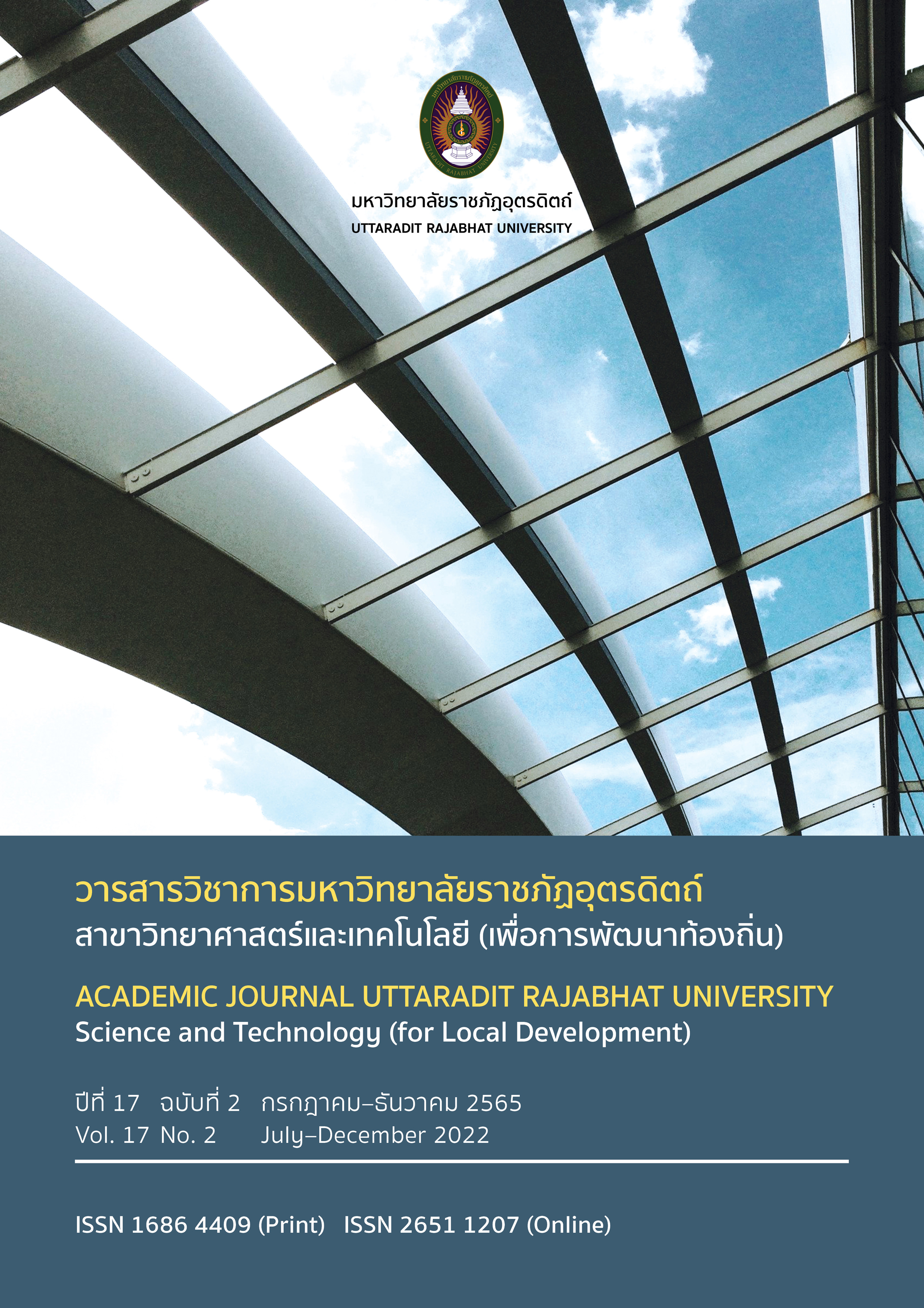A STUDY OF SOIL POLLUTANT CONTAMINATIONS FROM PADDY FIELDS IN THAWI WATTHANA SUBDISTRICT, SAI NOI DISTRICT, NONTHABURI PROVINCE
Main Article Content
Abstract
This purpose of research was to investigate the soil pollutant contaminations where pesticides were used in paddy fields of Thawi Watthana Subdistrict, Sai Noi District in Nonthaburi Province. This study applied a quantitative research model. Soil samples were collected at the study area by simple random sampling to cover the area amounting to 10 plots. Soil pollution in this investigative study was divided into 2 groups: heavy metals including selenium, manganese, copper, chromium, zinc, nickel, arsenic, cadmium, lead and mercury, and the group of pesticides, including insecticides and herbicides. The data was analyzed to differentiate with the statistics and soil quality standard with SPSS for t-test. The result revealed that there were heavy metal contaminants such as selenium, manganese, copper, chromium, zinc and nickel. Selenium were found in all plots which exceeded the soil quality standards and zinc in plot 9 which also exceeded standard. The heavy metal contents found in the study sites were statistically significantly different from the comparable standard values and found contamination of pesticides. Moreover, contamination of Methoprene, an insecticide which prohibits the transformation process of insects from larvae to adults, was found in plots 8 and 9. Its effect was to kill the eggs of insects. The research result pointed out that soil pollutants contaminated in the paddy fields were resulted from agrochemical use in the study area. Farmers and related agencies should consider preventing and reducing the use of agricultural chemicals to reduce the potential impact on people and the environment from exposure to pollutants. And further studies are needed on the absorption of pollutants into plants and yields.
Downloads
Article Details

This work is licensed under a Creative Commons Attribution-NonCommercial-NoDerivatives 4.0 International License.
References
กรมพัฒนาที่ดิน. กองการวิจัยและพัฒนาการจัดการที่ดิน. (2562). ข้อมูลการจัดการดิน. https://www.ldd.go.th/Web_Soil/polluted.htm#3
กรมพัฒนาที่ดิน. สำนักวิทยาศาสตร์เพื่อการพัฒนาที่ดิน. (2555). การเก็บตัวอย่างดินเพื่อวิเคราะห์สำหรับการปลูกพืช. https://osd101.ldd.go.th/?page_id=39
กรมวิชาการเกษตร. สำนักควบคุมพืชและวัสดุการเกษตร. (2563). รายละเอียดการนำเข้าวัตถุอันตรายทางการเกษตร. https://www.doa.go.th/ard/wp-content/uploads/2021/01/รายละเอียดการนำเข้าวัตถุอันตรายทางการเกษตร-ปี-2563.pdf
กระทรวงเกษตรและสหกรณ์. (2565). ฐานข้อมูลกลางเกษตรกรที่ได้รับใบรับรองมาตรฐานเกษตรอินทรีย์. https://organicmoac.ldd.go.th/agriculture/#/reports
กระทรวงดิจิทัลเพื่อเศรษฐกิจและสังคม. สำนักงานสถิติแห่งชาติ. (2563). สรุปผลการสำรวจภาวะการทำงานของประชากร. http://www.nso.go.th/sites/2014/DocLib13/ด้านสังคม/สาขาแรงงาน/ภาวะการทำงานของประชากร/2563/Report_02-63.pdf
กระทรวงทรัพยากรธรรมชาติและสิ่งแวดล้อม. กรมควบคุมมลพิษ. (2564). ประกาศคณะกรรมการสิ่งแวดล้อมแห่งชาติ เรื่อง กำหนดมาตรฐานคุณภาพดิน. https://www.pcd.go.th/laws/25162
กัญญ์สิริ จันทร์เจริญ. (2554). การกำหนดประชากรและกลุ่มตัวอย่าง. มหาวิทยาลัยพะเยา. https://shorturl.asia/50Zkp
คัดคณัฐ ชื่นวงศ์อรุณ. (2563, 26 มกราคม). มลพิษในดิน (Soil Pollution). National Geographic. https://ngthai.com/science/27458/soil-pollution/
ซีลีเนียม. (2563). http://mutualselfcare.org/medicine/holistic/element-selenium.aspx?M=k&G=f
ทนงศักดิ์ ปะระไทย. (ม.ป.ป.). ความสัมพันธ์ระหว่างธาตุอาหารพืชกับดิน. http://r07.ldd.go.th/Web/15_KM/S2.pdf
พนิดา ไชยยันต์บูรณ์. (2558). การพัฒนาการตรวจวิเคราะห์สารพิษตกค้างของวัตถุอันตรายทางการเกษตรให้ถูกต้อง แม่นยำตามมาตรฐานสากล (รายงานการวิจัย). https://www.doa.go.th/research/attachment.php?aid=2219
ภัทราวดี วัฒนสุนทร และจินตนา อมรสงวนสิน. (2559). การตรวจวิเคราะห์การตกค้างของสารกำจัดศัตรูพืชและสัตว์ในตัวอย่างดินจากนาข้าว ในพื้นที่จังหวัดชัยนาท. วารสารวิชาการมหาวิทยาลัยราชภัฏอุตรดิตถ์, 11(2), 245–258.
มหาวิทยาลัยมหิดล. (2562, 4 มกราคม). คู่มือบริการตรวจวิเคราะห์ตัวอย่างผลิตภัณฑ์เกษตร ผัก ผลไม้ น้ำ ดิน. https://mt.mahidol.ac.th/wp-content/uploads/2019/10/1-foodsafety_guidebook-2562.pdf
วรรธนศักดิ์ สุขสง, รวี จันทรัตน์, สรพงค์ เบญจศรี, และวิชุดา กล้าเวช. (2556). ปริมาณโลหะหนักสะสมในดินที่ทำการเกษตรเคมีในอำเภอป่าพะยอม จังหวัดพัทลุง. ใน การประชุมวิชาการแห่งชาติ มหาวิทยาลัยเกษตรศาสตร์ วิทยาเขตกำแพงแสน ครั้งที่ 10 (น. 248–255). มหาวิทยาลัยเกษตรศาสตร์ วิทยาเขตกำแพงแสน.
ศิริอุมา เจาะจิตต์, วิยดา กวานเหียน, อุดมรัตน์ วัฒนสิทธิ์, พิมาน ธีระรัตนสุนทร, สุภาภรณ์ ยิ้มเที่ยง, จันจิรา มหาบุญ, และปนัดดา พิบูลย์. (2560). การเปรียบเทียบความรู้ ทัศนคติ พฤติกรรมของเกษตรกรผู้ปลูกข้าว และปริมาณสารกำจัดศัตรูพืชตกค้างในสิ่งแวดล้อม จังหวัดนครศรีธรรมราช. วารสารความปลอดภัยและสุขภาพ, 10(37), 10–20.
สยาม อรุณศรีมรกต, วรพร สังเนตร, และปิยะรักษ์ ประดับเพชรรัตน์. (2560). การใช้สารเคมีในการทำนาข้าวของเกษตรกรในอำเภอหนองเสือ จังหวัดปทุมธานี. วารสารเกษตรพระวรุณ, 14(2), 173–180.
สำนักงานเกษตรจังหวัดนนทบุรี. (2563). ข้อมูลพื้นฐานด้านการเกษตร ระดับจังหวัด ประจำปี 2563. http://www.nonthaburi.doae.go.th/statisticss/statistic63.pdf
สำนักงานเกษตรอำเภอไทรน้อย. (2563). ข้อมูลพื้นฐานด้านการเกษตร. สำนักงานฯ.
สำนักงานเศรษฐกิจการเกษตร. (2562). เนื้อที่ใช้ประโยชน์ทางการเกษตร รายจังหวัด ปี พ.ศ. 2562. https://www.oae.go.th/assets/portals/1/files/socio/LandUtilization2562.pdf
สุธาสินี อั้งสูงเนิน. (2558). ผลกระทบต่อสิ่งแวดล้อมจากการใช้สารเคมีกำจัดศัตรูพืช. วารสารวิชาการมหาวิทยาลัยอีสเทิร์นเอเชีย ฉบับวิทยาศาสตร์และเทคโนโลยี, 9(1), 50–63.
สุภราดา สุคนธาภิรมย์ ณ พัทลุง, เสาวนิตย์ โพธิ์พูนศักดิ์, ศรีจำนรรจ์ ศรีจันทรา, และพฤทธิชาติ ปุญวัฒโท. (2563). เอกสารวิชาการ คำแนะนำการป้องกันกำจัดแมลง–สัตว์ศัตรูพืช อย่างมีประสิทธิภาพและปลอดภัยจากงานวิจัย. กรมวิชาการเกษตร.
องค์การบริหารส่วนจังหวัดนนทบุรี. (2557). ลักษณะสังคม. http://nont-pro.go.th/public/social/data/index/menu/25
Denneman, C. A., & Robberse, J. G. (1990). Target values are specified to indicate desirable maximum levels of elements in unpolluted soils. https://www.omicsonline.org/articles-images/2161-0525-5-334-t011.html
FAO (Food and Agriculture Organization of the United Nations). (2020). Soil testing methods – Global Soil Doctors Programme – A farmer-to-farmer training programme. Rome. https://doi.org/10.4060/ca2796en
IRAC (Insecticide Resistance Action Committee). (2020). IRAC Mode of Action Classification Scheme. https://irac-online.org/
MacFarquhar, J. K., Broussard, D. L., Melstrom, P., Hutchinson, R., Wolkin, A., Martin, C., Burk, R. F., Dunn, J. R., Green, A. L., Hammond, R., Schaffner, W., & Jones, T. F. (2010). Acute Selenium Toxicity Associated with a Dietary Supplement. Archives of internal medicine, 170(3), 256–261

